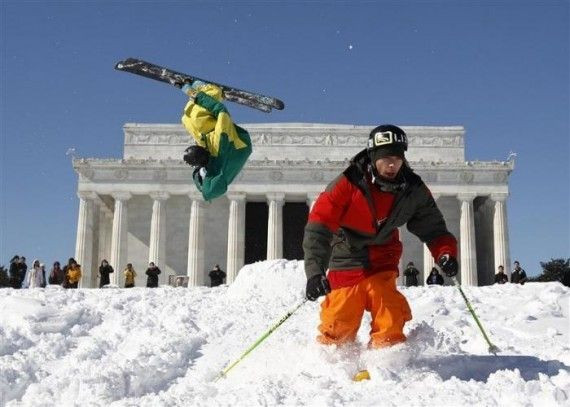Warm-to-Freezing Winter Temperature Fluctuations May be Connected to Global Warming: Study

While millions in the Northeast were shocked by the icy rain and snow that met them over the weekend, only days after temperatures hovered in 60s F, the October winter storm may not be as surprising as it initially seemed.
In fact, during the past two winters regions of the northern hemisphere have resulted not only in the record-setting freezes -- there have also been extreme, although less newsworthy, warm spells. However, according to an analysis from the American Geophysical Union, the warm extremes were more widespread and severe than the cold extremes in the winters of 2009-2010 and 2010-2011. While the cold temperatures were attributed to the natural climate cycle, researchers concluded the extreme warmth was not.
We investigated the relationships between prominent natural climate modes and extreme temperatures, both warm and cold. Natural climate variability explained the cold extremes; the observed warmth was consistent with a long-term warming trend, said Kristen Guirguis, a postdoctoral researcher at Scripps Institution of Oceanography, UC San Diego and lead author of the study.
The Data Set
Researchers tracked extreme temperature variations for the past 63 winters to compare the warm and cold extremes to the most recent winters. Guirguis' team concluded the extreme colds -- of which the 2009-2010 winter ranked 21 while the 2010-2011 came in at 34 -- fell into temperatures expected during the negative phase of the North Atlantic Oscillation, a climate phenomenon in the North Atlantic Ocean that is known to bring cold weather to the Eastern North American and Eurasia.
Meanwhile, for the warm extremes the two winter seasons ranked much higher, at 12 and 4 respectively.
Scientists compared the extreme warm outbreaks over the past two winters with the indices of both El Niño and the North Atlantic Oscillation, but could not reveal a natural reason for the temperature spikes.
Even though the cold events seem to be driven by a natural cycle, Alexander Gershunov, a report co-author and Scripps climate researchers, said it is still consistent with global warming trends.
Over the last couple of years, natural variability seemed to produce the cold extremes, while the warm extremes kept trending just as one would expect in a period of accelerating global warming, he said.
Increased snowfall may even be connected to warmer temperatures -- meaning global warming could be contributing to instances of heavy snowfall over the past few winters, such as the notorious snowmageddon of the 2009-2010 season.
A 2006 study from the American Meteorological Society, called Temporal and Spatial Characteristics of Snowstorms in the Contiguous United States found that a warmer future climate may spawn more winter storms.
In an analysis of winter seasons between 1901 and 2000, the report found the U.S. has experienced 61 percent to 80 percent of its November-December winter storms in warmer-than-normal years. Moreover, a review of January-February temperature conditions again show the U.S. had 71 percent to 80 percent of snowstorms in warmer years, while the March-April period also saw 61 percent to 80 percent of snowfalls during unseasonably warm years.
© Copyright IBTimes 2025. All rights reserved.





















